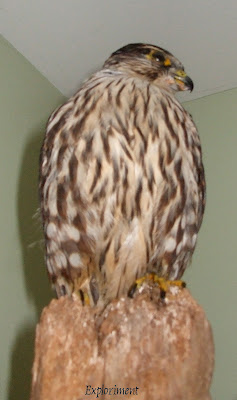On Remembrance Day last year, my friend Andrew was walking back towards his house after walking his son to school. As he walked up the driveway, a flight of doves took off from the bird feeder beside their house. He was startled when a bird crashed to the ground, at most a meter from where he was standing. His initial thought was that it was a mourning dove. When he got closer and inspected it he realized it was a bird of prey. At first he thought it was a hawk, but then realized that it was a falcon. Initially he was afraid that it was a Peregrine falcon. Very carefully he picked it up, thinking it might just be stunned. When the head lolled back, with no support at all, he realized it was dead.
He got in touch with the local Peregrine falcon preservation people, telling them he was worried that one of these rare birds may just have fallen from the sky right next to him.
“Can you send us some pictures?”
“Can you send us some pictures?”
He laid the bird out and took several photos, capturing as much detail as he could and emailed them. He got a phone call back a few minutes later, and was informed that he had a Merlin falcon.
Now Merlins, aren’t quite as rare as Peregrines, but that’s not to say they’re that common either. They’re fairly uncommon in urban areas, as they prefer more forested areas. (Peregrines are seen in urban areas because tall buildings serve as analogs for their preferred habitat – cliffs.) Due to a very large park right near where we’re located, it may have ventured down from the Niagara Escarpment to hunt the area. Their preferred prey are doves and pigeons (the colloquial name for them is “pigeon hawks”), and the bird feeder had certainly been attracting them. Andrew figured that it may have been perched in a nearby tree, swooped in for a dove, and clipped a wire, which broke its neck, and crashed to the ground, or it clipped a wire, and crashed to the ground, which broke its neck.
Andrew called his uncle, Bruce Lepper, who happens to be an award winning bird carver, and asked him how to proceed.
“You have a merlin?! What? Really? The bird we have to carve for the championships this year is a Merlin! What are you going to do with it?”
“Well, I thought of having it taxidermied, but I don’t know the first thing about it.”
“First you need to get a permit from the Ministry of Natural Resources. Technically you’re not even allowed to be in possession of the bird without it and no taxidermist will touch it unless you have that permit. And when you have that, there’s a guy near you, Jim Jackson, that can do it for you. He’s also a bird carver, so he’ll really dig working on that. Wrap it up in paper towels, and then a towel and put it in the freezer.”
The next day Andrew and I took a drive down to Vineland where the nearest MNR office is located.
The gal from the MNR inspected the bird and filled out paperwork as to where, when, how, all those things. I think they want to inspect the bird, partly to see that it hadn’t been killed due to foul play, and I think it also helps them build up a picture of numbers, distribution, mortality rates, etc. Andrew was given back the Merlin and was told that the permit would be mailed to him.
The bird looked a little freaky because the freezing had damaged the eye.
When the permit came, Andrew took it to Jim. He had already been in discussion with Bruce, as to how to pose the falcon. Since the championships required the participants to carve a falcon, the ability to show up with a real (albeit taxidermied) falcon and have the two sitting side by side would be a real boon. Also having the original for colour studies, and studying subtle details, like feathers, and such would be very beneficial. Photos help, but not nearly to the level of a real animal.
We went on Friday night to pick up the completed falcon, and it was pretty spectacular. Jim’s a real character. Will talk your ear off. His space is stuffed to bursting with taxidermied animals of all shapes and sorts. He had a Merlin, but it was about thirty years old, and you could tell he really liked this new one a lot. His aim is to build up a collection of every bird to be found in Ontario and eventually donate it to an educational institution.
While it’s sad that this beautiful bird was killed, it died right near someone who was pretty upset about it, and had the wherewithal to do something positive about it. Not only has it been permanently preserved, but it will also be preserved as a masterful carving. I suspect that they get killed out in the country as well by hitting power lines or collisions with vehicles, but likely end up in a ditch where they just get eaten by scavengers. This one died in just the right spot.

































It's nice that at least the bird went on to preserve natural history. When I was in grade school (Montessori) if we ever found on the playground a dead animal we could all hurry it into the freezer per the teachers instruction. Then we would take up a collection and have it stuffed and would then learn about the bird species thoroughly.
ReplyDelete